Welcome to my first guest post! Today we’re hearing from Dr. Amy Sprenkle (https://www.salemstate.edu/academics/schools/1046.php?id=736) from my home institution, Salem State University (https://www.salemstate.edu).
***************************************************************************************************************
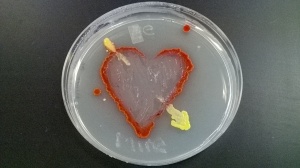
The annual Darwin Festival (http://w3.salemstate.edu/~pkelly/darwin/) coincides with Valentine’s day each year, and I usually invite my microbiology students to create ‘valentines’ by using bacterial cultures that have a macroscopic appearance that is opaque and colorful after growing on an agar plate. This year we shared them at the Darwin Festival.
“But why did you do it?” asked Lisa.
I could come up with many scientific reasons why allowing the students to ‘paint’ with bacteria is a good idea; reminders of the aspects of good aseptic technique, or the study of the interaction of the different cultures as they grow on the plate are just two, but I think the most important reason is that it helps to demystify bacteria, and perhaps break down some ‘germophobe’ walls that have been built in some individuals since childhood. As a microbiologist, I consider germophobes to have a certain lack of intellectual curiosity, and a lack of openness to new ideas, especially in microbiology! 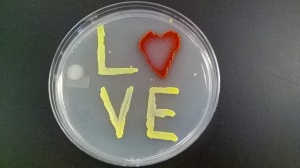
Thinking of bacteria as a medium of art, rather than germs to be feared and removed at all costs, makes manipulating them a lot less scary. Not being assessed on the success of the project also makes it more fun and less threatening
(but many students don’t bother to do the valentine because it’s not required). The best thing in being released from the fear of manipulating bacteria is that it gets one thinking about the ways in which we use microbes to our benefit; in food production and agriculture, bioremediation, biotechnology, and most importantly as a part of our resident microbiota that is so crucial to our health.
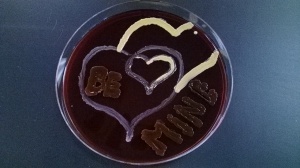 Finally, the delayed gratification that comes with making light ‘brush strokes’ with a sterile toothpick to place microscopic cells on the growth medium, and then to come in the next day and see that your sketch idea has bloomed into color and completion is one that applies to laboratory science and experimentation in general. Just finding out if you like the fine motor manipulation, the suspense of the wait, and the excitement and surprise of the result is a good thing to learn early in career exploration, no? You can find much more of the same on the web here: http://www.microbialart.com/more/
Finally, the delayed gratification that comes with making light ‘brush strokes’ with a sterile toothpick to place microscopic cells on the growth medium, and then to come in the next day and see that your sketch idea has bloomed into color and completion is one that applies to laboratory science and experimentation in general. Just finding out if you like the fine motor manipulation, the suspense of the wait, and the excitement and surprise of the result is a good thing to learn early in career exploration, no? You can find much more of the same on the web here: http://www.microbialart.com/more/

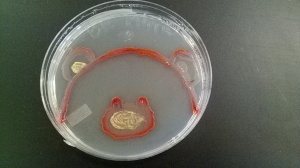
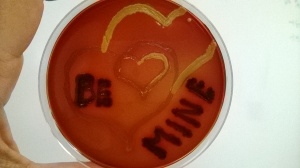
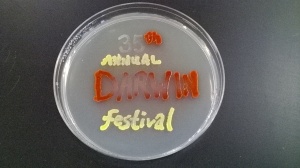


You must be logged in to post a comment.